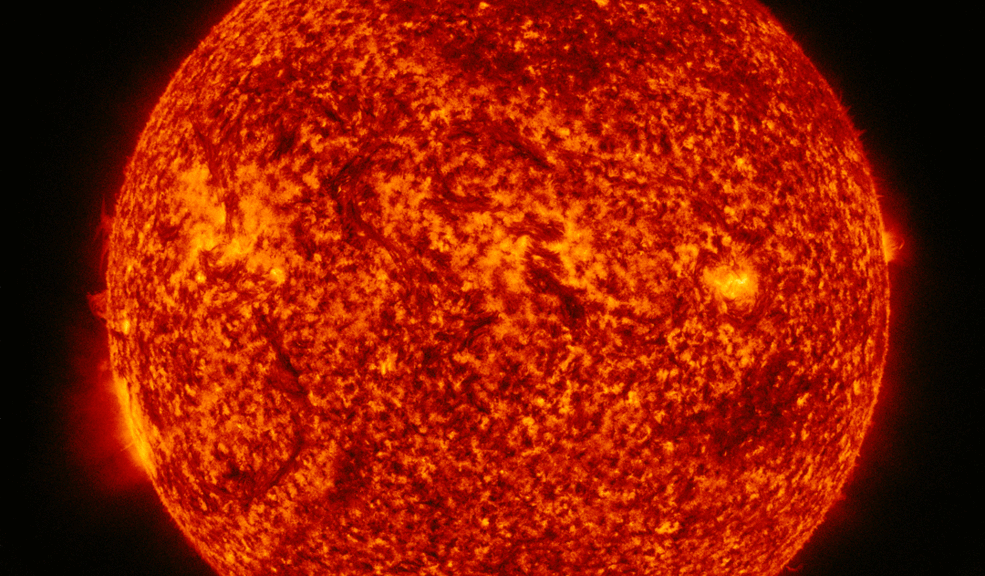
NASA’s Solar Dynamics Observatory, or SDO, captured images of a partial solar eclipse in space when it caught the moon passing in front of the sun on 10/30/16. Seen in this animated GIF, the lunar transit lasted for about one hour. (NASA’s Goddard Space Flight Center/SDO/Joy Ng)

A Soyuz MS-02 spacecraft is rolled out by train to its Baikonur Cosmodrome launch pad on 10/16/16. The rocket sent International Space Station Expedition 49 flight engineer Shane Kimbrough of NASA, Soyuz commander Sergey Ryzhikov of Roscosmos, and flight engineer Andrey Borisenko of Roscosmos on 10/19/16. (NASA)

With the arrival of a new trio of International Space Station crewmembers just days earlier, another group that had been aboard for months climbed into their Soyuz MS-01 spacecraft for their trip home. Here you see the capsule carrying members of the ISS Expedition 49 – Kate Rubins of NASA, Anatoly Ivanishin of Roscosmos, and Takuya Onishi of the Japan Aerospace Exploration Agency (JAXA) – coming in for touchdown near the town of Zhezkazgan, Kazakhstan on 10/30/16. (NASA)

Another ISS image for you. Here an Orbital ATK’s Cygnus cargo spacecraft launched a few days earlier from NASA’s Wallops Island, Va., spaceport is seen being captured by the Canadarm2 robotic arm on the International Space Station on 10/17/16. The resupply ship was packed with more than 2,300 kilos of cargo and research equipment. (NASA)

This is a camera system being by the US National Ocean and Atmospheric Administration to study and overall health of deep-water bottom fish species around the Hawaiian Islands. The second of two phases of this survey began in mid-October. It brought local commercial fishermen and scientists together to get a count of several species of deep-water grouper and snapper, which are popular table fare. (AP)

On 10/26/16, scientists announced the discovery of the L1448 IRS3B system, which is a rare triple-star system located some 750 light-years from Earth. The scientists, who made their discovery with the Atacama Large Milimeter/submillimeter Array or ALMA, in Chile say their discovery supports evidence of disk fragmentation—a process that leads to the formation of young binary and multiple star systems. (University of Oklahoma and ALMA)

Many of us already have heard about the development of cars that drive themselves, now a company called Aurora Flight Sciences is testing a robotic system that can co-pilot an aircraft. Called the Aircrew Labor In-Cockpit Automation System (ALIAS), the unit can be seen mounted in the co-pilot seat of a Cessna Caravan aircraft which is preparing for take-off at Manassas Airport in Manassas, Va., on 10/17/16. It is hoped that ALIAS can someday eliminate the need for a second human pilot in the cockpit. (AP)

NASA released this image showing a haze layer encircling Pluto on 10/08/16. The planet was photographed by the New Horizons spacecraft’s during its July 14, 2015 flyby. Using a variety of near-infrared observational information, the image was created with special software to look as close to how a human eye would see it. (NASA/JHUAPL/SwRI via AP)

We love to show you Robots in action. Here is a squad of robotic cheerleaders, developed by Japan’s Murata Manufacturing Co., perform synchronized dancing on 10/06/16 during the annual CEATEC Japan advanced technologies show in the nation’s Chiba prefecture. The robo-cheerleaders shook color changing pom-poms. You can also see the bicyclist robot, named, “Murata Seisaku-kun”, or Murata Boy in the background. (AP)

Colorized composite image of ESA’s ExoMars Schiaparelli module elements capture by NASA’s Mars Reconnaissance Orbiter High Resolution Imaging Science Experiment (HiRISE) on 1 November 2016. Both the main impact site (top) and the region with the parachute and rear heatshield (bottom left) are now captured in the central portion of the HiRISE imaging swath that is imaged through three different filters, enabling a colour image to be constructed. The front heatshield (bottom right) lies outside the central colour imaging swath. (NASA/JPL-Caltech/University of Arizona)

The Context Camera on the NASA’s Mars Reconnaissance Orbiter caught before-and-after images of two spots that likely appeared in connection with the 10/19/16 arrival of the European Space Agency’s Schiaparelli test lander on Mars. Due to technical malfunctions during landing, it is believed the lander crashed into the Martian surface. (NASA/JPL-Caltech/MSSS)






















Had the Reconnaissance Orbiter be painted with squares black and white we would be able to recognized it better!
I don’t know if it is not a black rock from space that land there.
Hi! NASA just released a composite colorized version of the impact… I’ve added it to the page. Thanks!